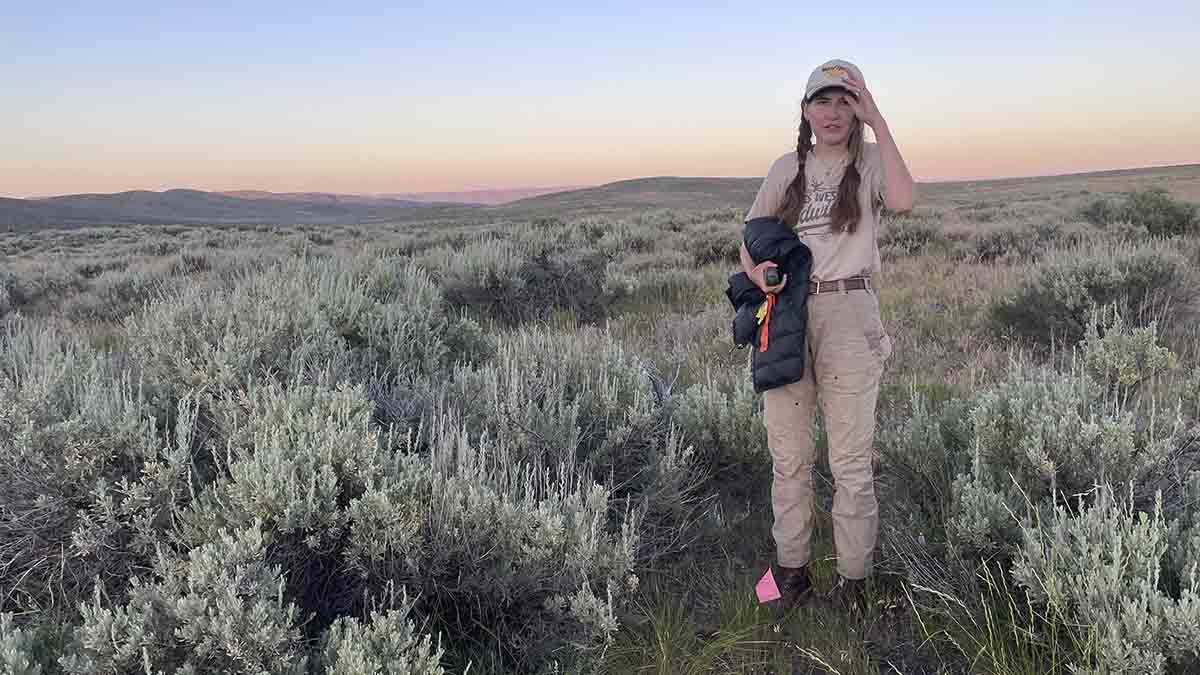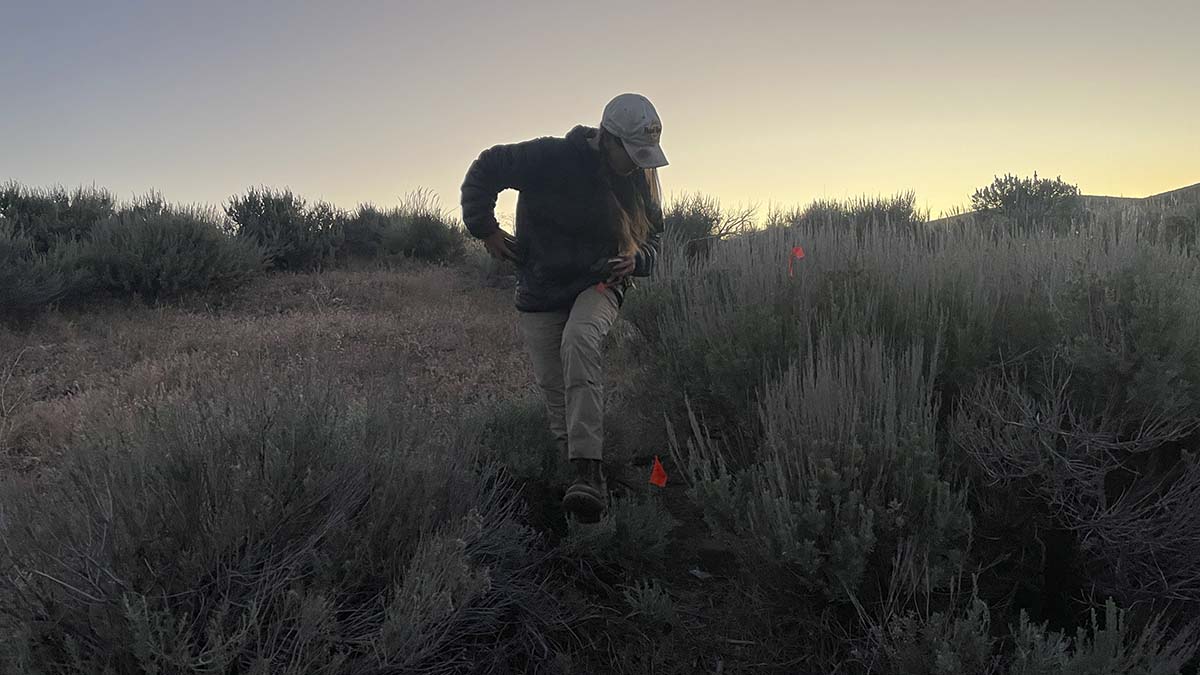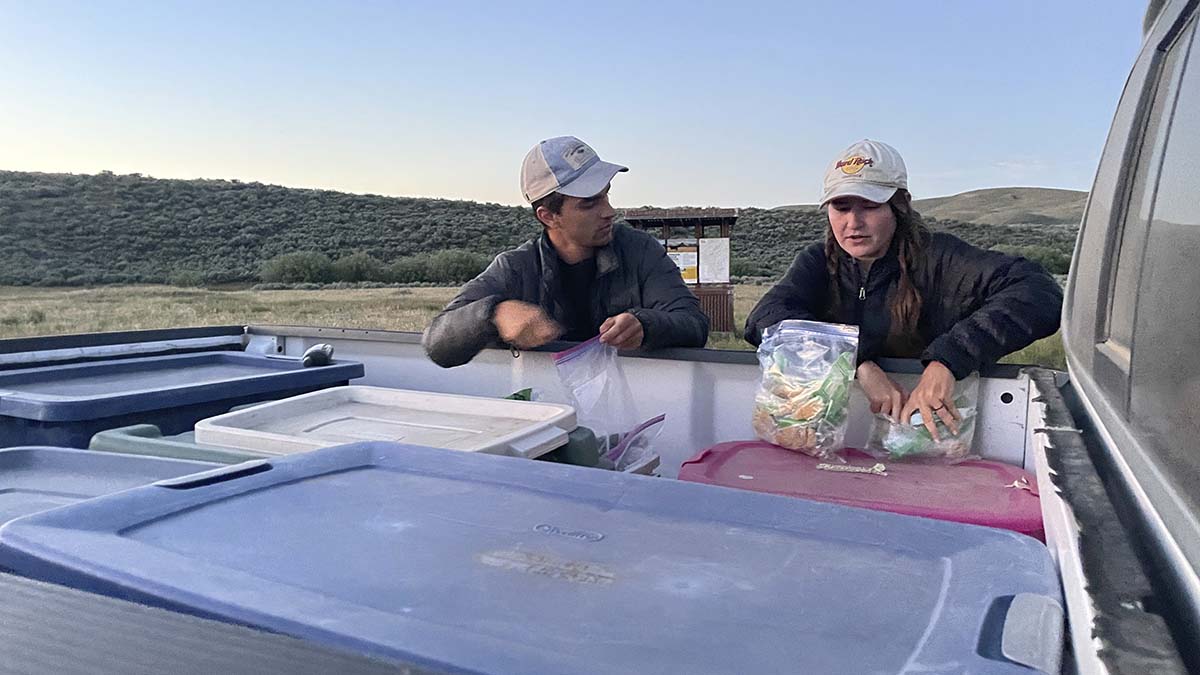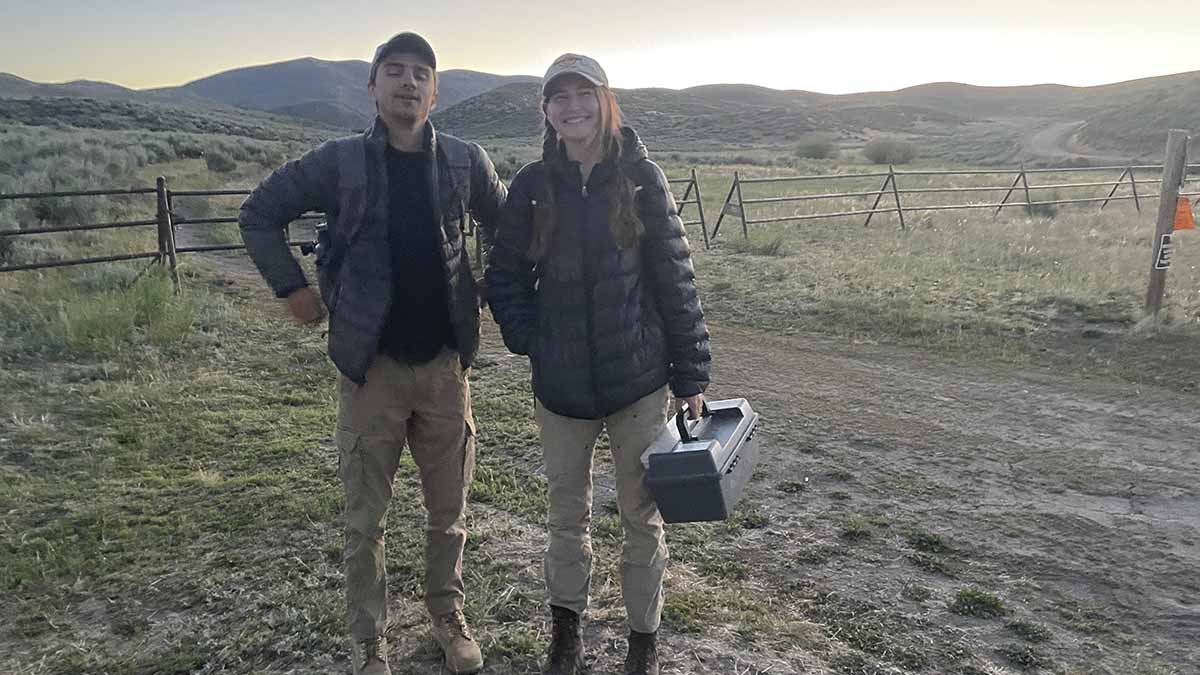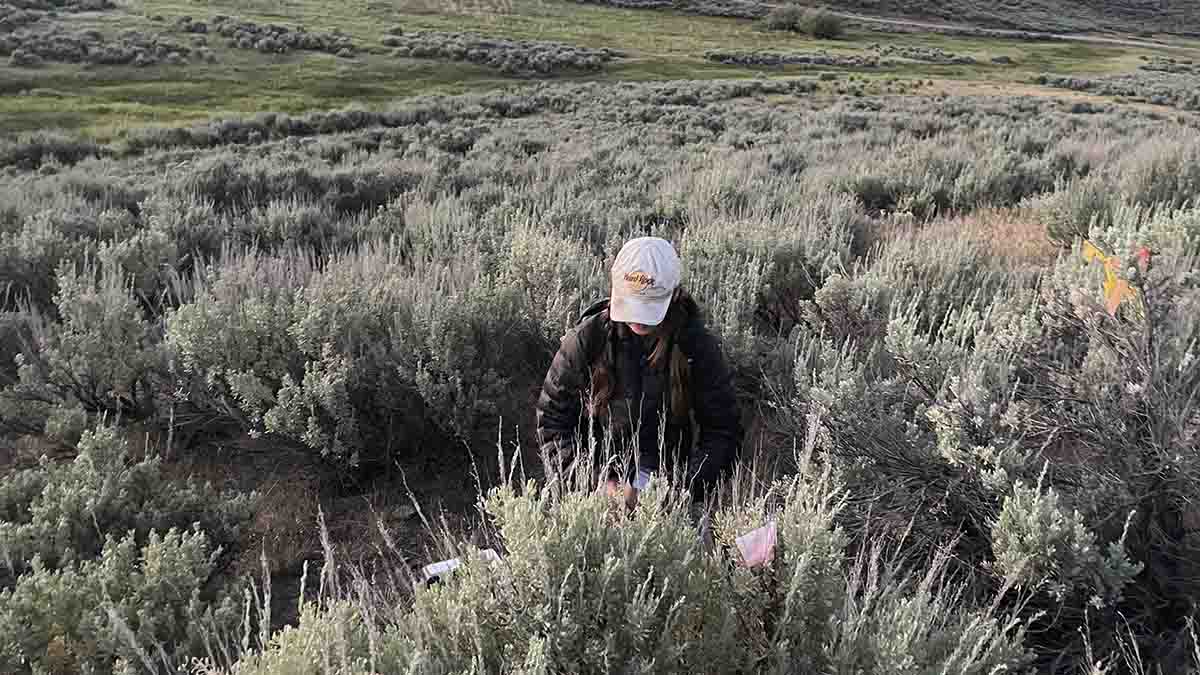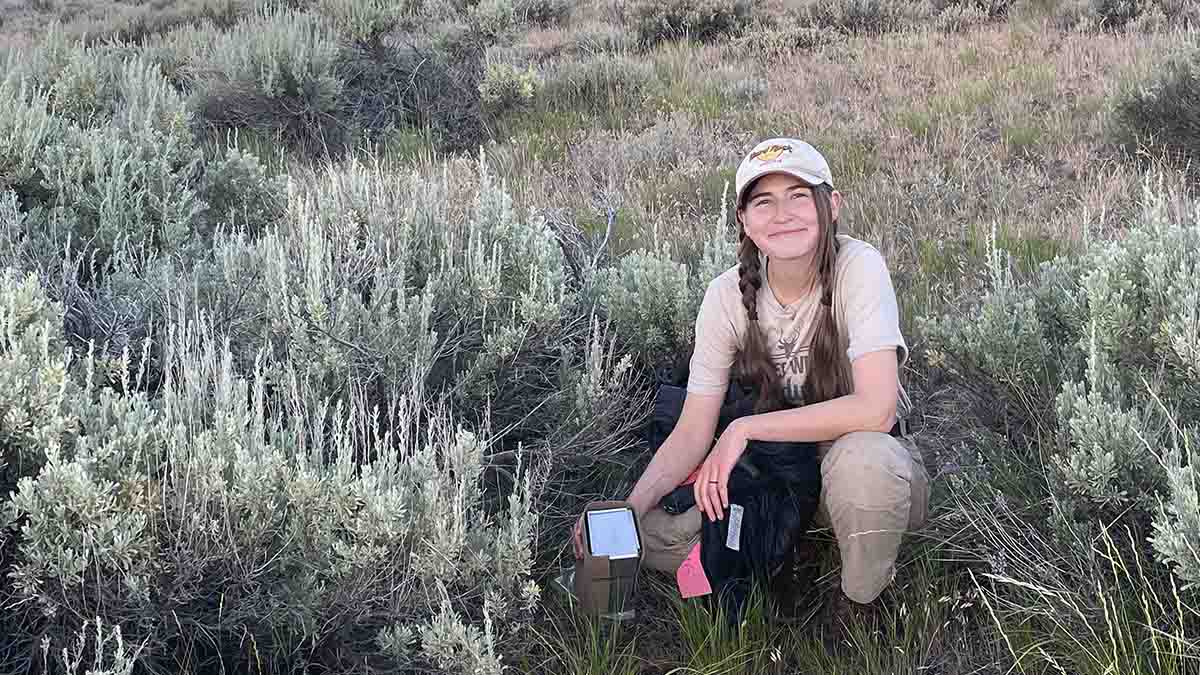Rodent Research
Cow Camp is dark and quiet when Kirby Lau and Harrison Eckard-Garrett emerge from their canvas wall tents with gear in hand at 4:30 a.m.
Their pickup truck rumbles along a rutted, dirt road over sagebrush-covered hills within University of Idaho’s Rinker Rock Creek Ranch, located in the Wood River Valley in the state’s southcentral region. They arrive at their research site just as the sun begins to rise over the Pioneer Mountains. After assembling their kits, they split up to cover more ground, knowing their success rate at trapping rodents has been steadily increasing and it’s likely to be a long morning.
Lau, of North Carolina, is a U of I graduate student seeking a master’s degree in natural resources, with an emphasis on wildlife. The thesis project she began in the fall of 2022 involves studying how applications of the long-lasting herbicide Rejuvra affect sage grouse and small mammal ecology.
Federal land managers believe Rejuvra, which contains the active ingredient indaziflam, could provide a more cost-effective and longer-lasting tool in their efforts to control invasive annual grasses. Rejuvra treatments were made at the research site in 2019 and 2020.
“We’re going to see how the herbicide affects the vegetation and how the vegetation affects use by rodents and grouse,” Lau says. “There’s quite a bit of cheatgrass and field brome here. Our hope is the herbicide will control annuals and release native perennials from competition with the annuals.”
Data Collection
Every evening, Lau and Eckard-Garrett, who is the research technician she hired to aid in data collection, use peanut butter, oats and sunflower seeds to bait nearly 200 metal-box Sherman traps spaced 10 meters apart throughout the sagebrush steppe. They return at the crack of dawn the following morning to check their traps, affixing ear tags on every captured rodent and recording their size and location — as well as the tag number of any rodent that was previously captured. Such recaptures give them insights into rodents’ distribution, survival and ability to find resources within treated areas.
Thus far, it appears to Lau that there are no obvious negative impacts on grouse habitat use in tracts treated with the herbicide, and there is potential for increased use in these areas. Prior work at the ranch analyzed plant community responses and changes in fire risk following Rejuvra applications.
Research at Rinker Rock Creek Ranch is conducted in partnership by the College of Agricultural and Life Sciences (CALS) and the College of Natural Resources (CNR). Tim Prather, a professor of plant science in CALS and associate director of the U of I Rangeland Center, and Tracey Johnson, an associate professor in CNR and director of research at Rinker Rock Creek Ranch, are advisors on Lau’s thesis.
“When you take a look at the prevalence of fire in the sage steppe right now, having a tool like Rejuvra is really important to deal with that fire return interval and the size of the fires,” Prather says. “It’s also important as a public lands manager that you can confidently say your management action is not negatively impacting the native plant communities or the wildlife species within the plant communities where you’re using this herbicide.”
A Rodent Record
On this morning, she and Eckard-Garrett confirm about 50 metal boxes, marked by colorful flags, harbor pocket mice, deer mice, voles and the occasional chipmunk — a record for the project so far. Rodent populations are cyclical, and their numbers have exploded this summer.
Lau moves briskly from trap to trap, understanding time is of the essence to ensure the rodents are processed and released before the heat of day arrives.
Lau, who attended North Carolina State University and studied biology as an undergraduate, worked as a technician on wildlife projects for about three and a half years before seeing a job posting for her current master’s position at U of I.
“We hadn’t done any small mammal work at the ranch prior to this project,” Johnson says. “She didn’t have any baseline information on what she might catch or what the densities of small mammals might be. She was a little bit without some of the information that would have been nice to have, but she moved forward anyway and has been very successful.”
Sage Grouse Innovation
Regarding the other prong of her study, Lau pioneered a new method for monitoring sage grouse that promises to save future researchers considerable time in the field. The accepted way of estimating grouse use of habitat is typically checking for bird scat at specific intervals along predetermined lines through the landscape, known as transects. In addition to scat monitoring, Lau set up 45 trail cameras, remotely capturing 650 images of sage grouse using the habitat in 2023 alone. She was convinced advancements in software and artificial intelligence would enable her to succeed with trail cameras where others have failed.
Lau now plans to publish a separate scientific paper detailing how trail cameras and scat monitoring produced comparable results for estimating sage grouse use of control versus treated habitat. Aside from the time savings, researchers can glean additional information from images about grouse numbers, sex and behaviors.
“Nobody had really done that in the published literature — not only for sage grouse, but also for other ground-dwelling birds,” Johnson says. “I told her, ‘This is going to be a lot of extra work. If you want to drop that aspect of the project, I’m OK with that.’ Kirby said, ‘Let’s just try it.’ It paid off in dividends.”
Life at Cow Camp
Lau’s research has also entailed months of spartan living in an encampment known as Cow Camp. The primitive camp lacks running water, electricity, cell service and refrigeration. Yet Cow Camp has unique perks — spectacular sunsets, starry nights, a panoramic of mountain views, diverse wildlife and a quiet broken only by the sounds of nature.
Most importantly for Cow Camp’s residents, life at the ranch is an opportunity to work in a unique, living laboratory for rangeland research.
“I was very uncertain about how much I was going to enjoy coming out here,” says Eckard-Garrett, who recently earned a bachelor’s degree from Simpson College in central Iowa and shares Lau’s enthusiasm for small mammals. “This is the first time I’ve ever been out West for an extended period of time, and it’s been amazing.”
Lau’s research, “Impact of Annual Grass Removal Using Indaziflam on Sagebrush Associated Wildlife,” is funded with $110,268 through the U.S. Forest Service State and Private Pesticide Impact Assessment Program. She also received funding to hire Eckard-Garrett through the David Little Foundation, which offers a Rangeland Center grant.

Article and photos by John O’Connell, College of Agricultural and Life Sciences







